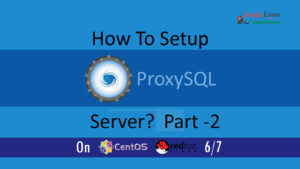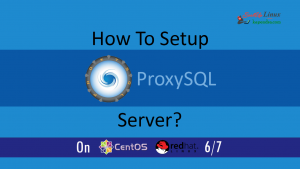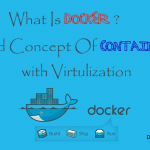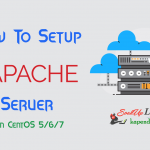Contact Us

How to Install WordPress 4.7 with Apache on RHEL/CentOS 6/7 and Fedora?
Introduction To WordPress
WordPress, one of the most in use CMS (Content Management System) system for website creation. It was developed using MySQL and PHP. It was introduced in the year 2003 and now it’s getting popular day by day because of its plugins available in a mass quantity. With the evolution of web servers, Apache and NGINX WordPress is also flourishing.
So, here we are for How to Install WordPress 4.7 with Apache on RHEL/CentOS 6/7 and Fedora? and By the end of this article, we will get aware of setting up WordPress with Apache/MySQL/MariaDB/PHP
If, looking for setting up WordPress with Nginx Read Full Article Here
Scenario:
- My Server IP is 168.1.188
- Up and Running MySQL – Read How to SetUP MySQL Server 5.5
- Up and Running Apache – Read How to SetUp Apache Server
- Up and Running PHP – Read How to Setup Custom PHP or PHP 5.4
Note: If you are a SUDO user then prefix every command with sudo, like #sudo ifconfig
In short, ALL we need is an up and running LAMP environment. Read what LAMP environment is and how to set up LMAP environment?
Here is a quick SetUp for LAMP environment
Let’s start
Step 1: Install Required Packages
To set up WordPress we might require few packages so please install following packages according to your system configuration, requirement, and OS version.
For RHEL/CentOS 7:
# yum install httpd mariadb mariadb-server php php-common php-mysql php-gd php-xml php-mbstring php-mcrypt php-fpm
For RHEL/CentOS 6 & Fedora 15-20:
# yum install httpd mysql mysql-server php php-common php-mysql php-gd php-xml php-mbstring php-mcrypt
For Fedora 21 Or Above:
# dnf install httpd mariadb mariadb-server php php-common php-mysql php-gd php-xml php-mbstring php-mcrypt
After successful installation of MySQL/MariaDB please start your MySQL server and run the following command to get some vulnerabilities removed from your MySQL/MariaDB server.
For CentOs/RHEL 7 and Fedora 22 or Above:
# systemctl start mariadb.service # mysql_secure_installation
For CentOs/RHEL 6 and Fedora 15 -21:
# service mysqld restart # mysql_secure_installation
Note: If Stuck Somewhere Please Read Article – Read How to SetUP MySQL Server 5.5
Step 2: Get WordPress
After installing Apache and MySQL we need the WordPress lump on our server. To get this download done you have to be the root user.
# cd /var/www/html # wget http://wordpress.org/latest.tar.gz
Step 3: Extracting WordPress Files
Now we will extract our WordPress files from this tarball and rename it ( If you want to ). Please run following command.
# tar -xvzf latest.tar.gz # rm -rf latest.tar.gz # mv wordpress wp_test # chmod -R 775 wp_test # chown -R apache:apache wp_test
Step 4: Creating MySQL User & Database
We need a database for up and running WordPress and a database user which will interact with the database for WordPress. Use the following series of command to login in database and to create database and MySQL user
#mysql -u root -p mysql>CREATE DATABASE wp_db; Query OK, 1 row affected (0.00 sec)
Now, we will create a new user. You can replace the name of database and password, with your preferences.
mysql >CREATE USER 'wp_user'@'localhost' identified by "password"; Query OK, 0 rows affected (0.00 sec)
Note: If you already have a user and want to change password you may use the following command
mysql>SET PASSWORD FOR 'wp_user'@'localhost'= PASSWORD("password");
Query OK, 0 rows affected (0.00 sec)
As we have our user and database created now let’s grant all required privileges and permissions
mysql>GRANT ALL PRIVILEGES ON wp_db.* TO 'wp_user'@'localhost'; Query OK, 0 rows affected (0.00 sec)
Now refresh MySQL with following command and exit
mysql>FLUSH PRIVILEGES; Query OK, 0 rows affected (0.00 sec) mysql>exit
Note: Highlighted values will be used later so please use accordingly and do as per your need. Also, if there is any problem in setting up mysql server read: – How to SetUP MySQL Server 5.5
Step 5: Creating Apache VirtualHost for WordPress
Here Are Two Conditions: First one, if you have a domain name for your WordPress installation then follow Setting 2 virtual host and if you want to run WordPress installation on localhost or IP then follow Setting 1 for the virtual host.
Setting 1: If Setting WordPress on IP or LocalHost
# vim /etc/httpd/conf.d/vhost.conf
Copy paste these given lines of code and change the highlighted values accordingly and as per your needs
NameVirtualHost *:80 <VirtualHost *:80> ServerName 192.168.1.188 #Your Server IP ServerAdmin [email protected] DocumentRoot /var/www/html/ DirectoryIndex index.php index.htm index.html ErrorLog /var/log/httpd/error_log CustomLog /var/log/httpd/access_log combined </VirtualHost> <Directory /var/www/html/> Options Indexes FollowSymLinks AllowOverride None order allow,deny allow from all </Directory>
Now save the file using the command #: wq!
Now Restart your Server for getting your changes in effect
For CentOs/RHEL 7 and Fedora 22 And Above:
# systemctl restart httpd.service
For CentOs/RHEL 6 and Fedora 15-21:
# service httpd restart
Setting 2: if want to install WordPress on a domain
# vim /etc/httpd/conf.d/vhost.conf
Copy paste these given lines of code and change the highlighted values accordingly and as per your needs
<VirtualHost *:80> ServerAdmin [email protected] DocumentRoot /var/www/html/wp_test ServerName test.kapendra.com #Your Domain Name ErrorLog /var/log/httpd/test.kapendra.com-error-log CustomLog /var/log/httpd/test.kapendra.com-access-log common </VirtualHost>
Now Restart your Server for getting your changes in effect
For CentOs/RHEL 7 and Fedora 22 And Above:
# systemctl restart httpd.service
For CentOs/RHEL 6 and Fedora 15-21:
# service httpd restart
Step 6: Setting up WordPress
This is the key part of getting WordPress installation done. Make sure to make a copy of the default configuration file then make any changes. This configuration file is present in WordPress directory
#cd /var/www/html/wp_test #cp wp-config-sample.php wp-config.php
Then open the WordPress configuration file:
#vim wp-config.php
You will see content like this and make your changes to the following which I have highlighted.
// ** MySQL settings - You can get this info from your web host ** //
/** The name of the database for WordPress */
define('DB_NAME', 'wp_db');
/** MySQL database username */
define('DB_USER', 'wp_user');
/** MySQL database password */
define('DB_PASSWORD', 'password');
Write and quit the file using :wq!
Step 7: Finishing WordPress Installation and Verification
Now, Open your browser and type any of the following address as per your setting you chose above. I have done my installation using IP address so I will use http://192.168.1.188/wp_test
http://test.kapendra.com
http://localhost/wp_test (If System Is LocalHost)
http://your-ip/wp_test (If WordPress running on IP)
If everything goes right then you will be prompted for this
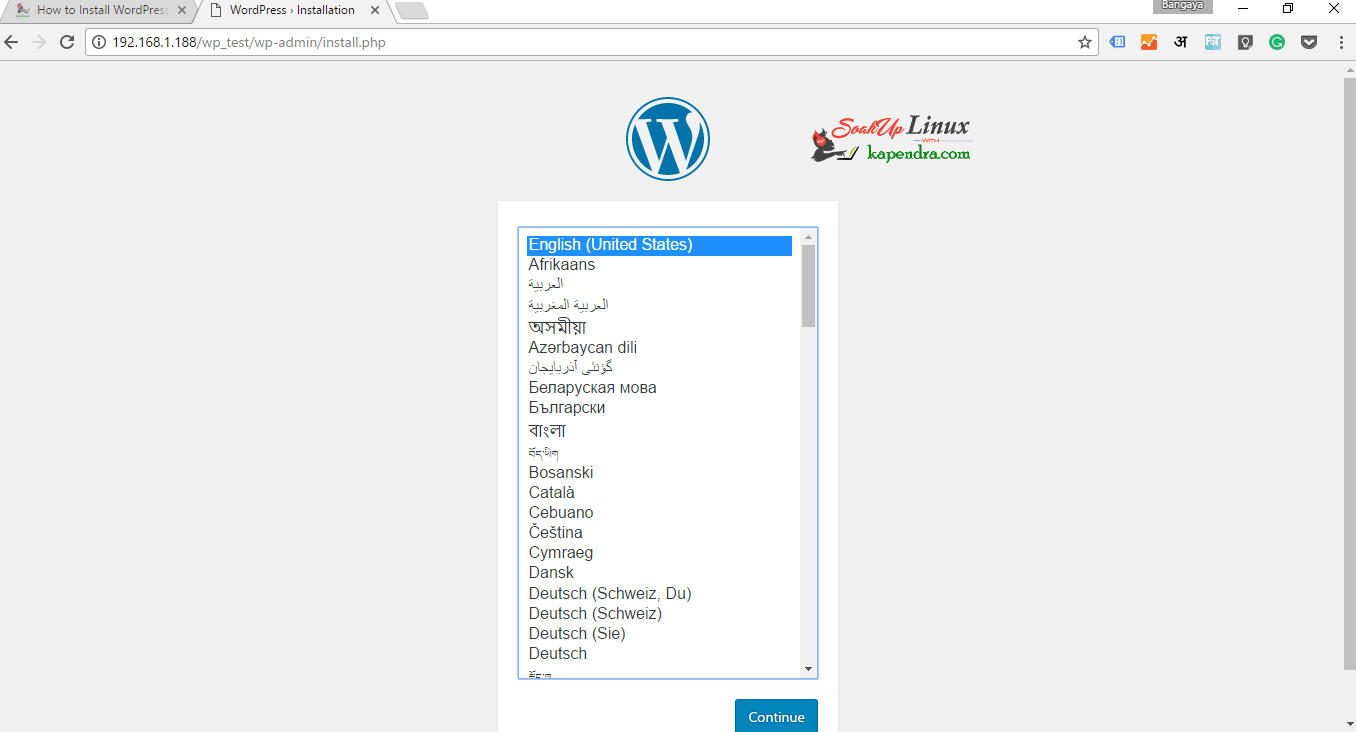
Now fill all the detailed like Site Title, Admin User, Admin Password, and Enter Your E-Mail and then hit Install button.
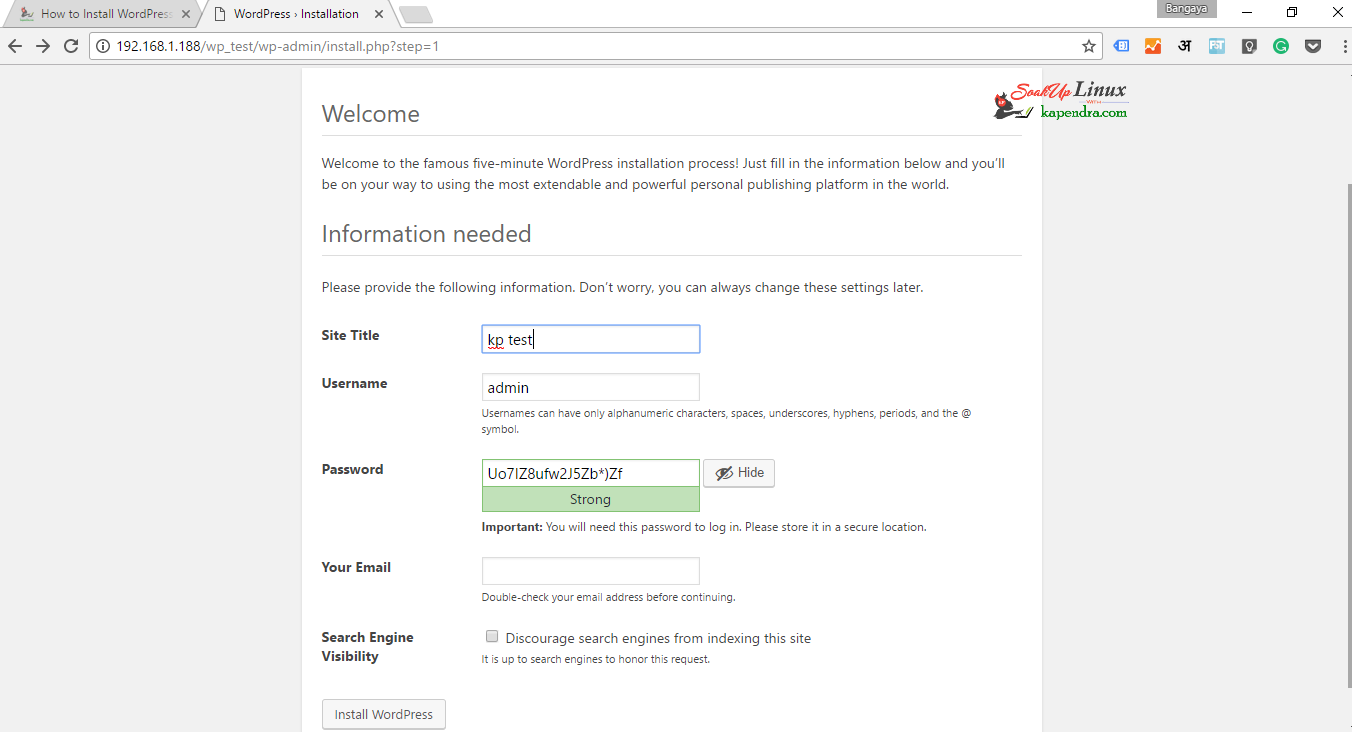
And you will have a site running on WordPress you may login into WordPress dashboard using
http://test.kapendra.com/wp-login
http://localhost/wp_test/wp-login/ (If system is Local)
http://your-ip/wp_test/wp-login/ (id WordPress running on IP)
Watch Video:
Coming Soon…


